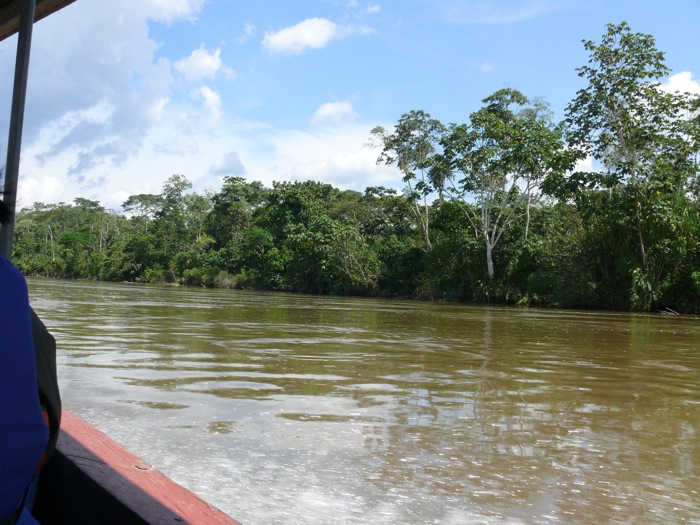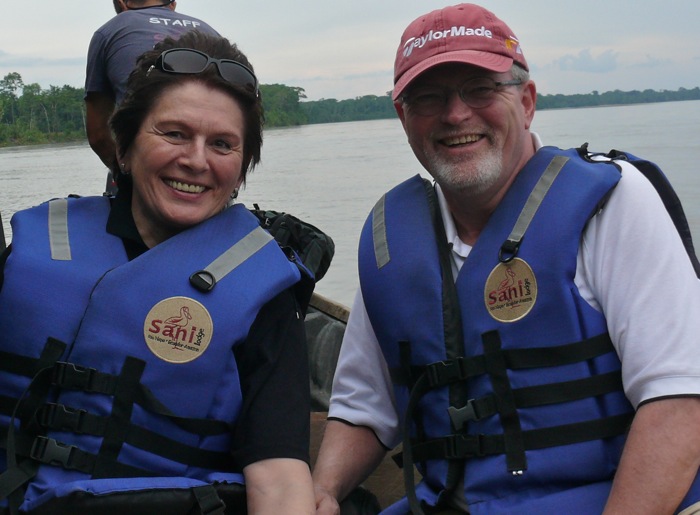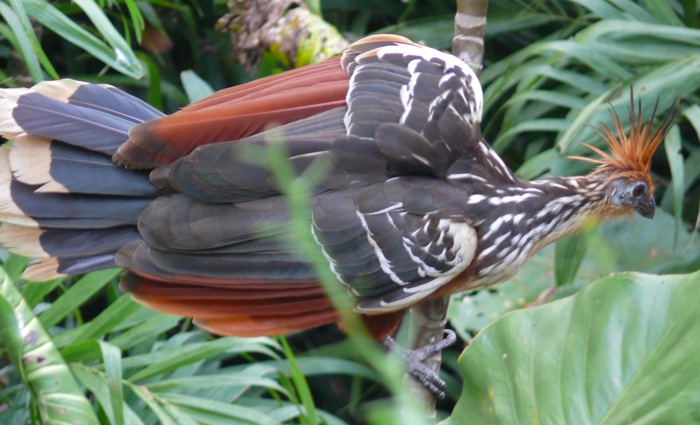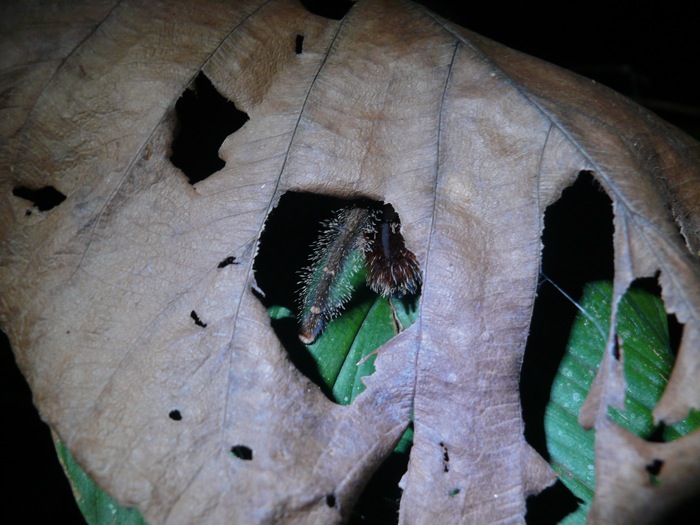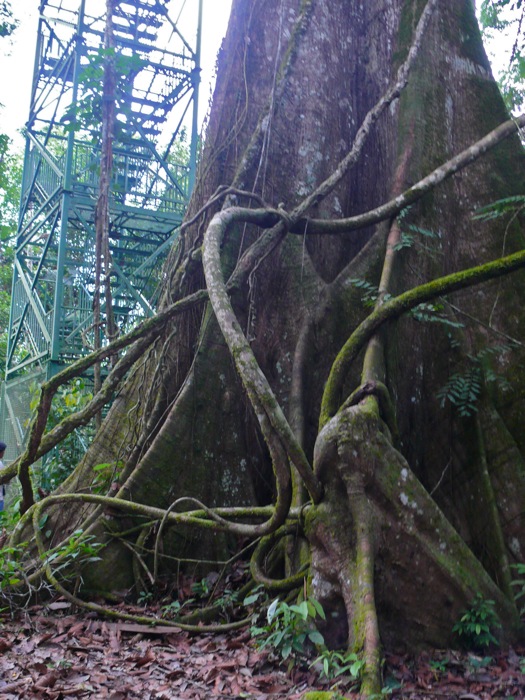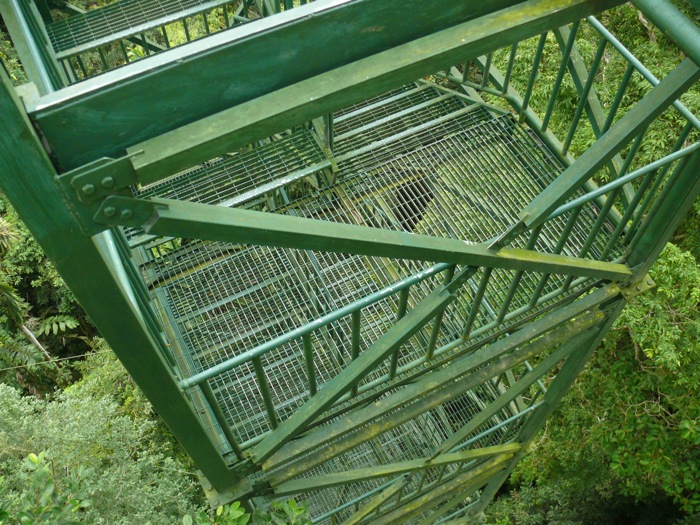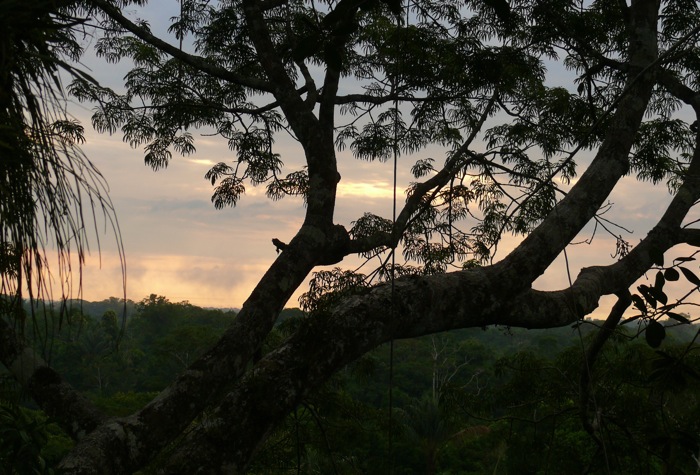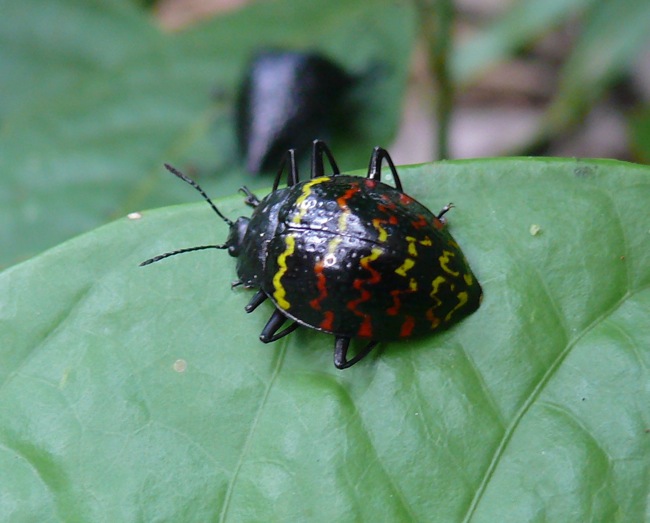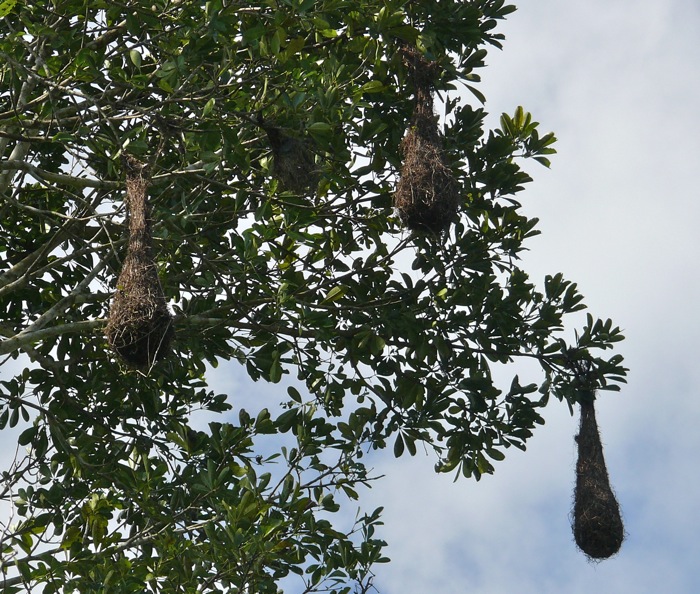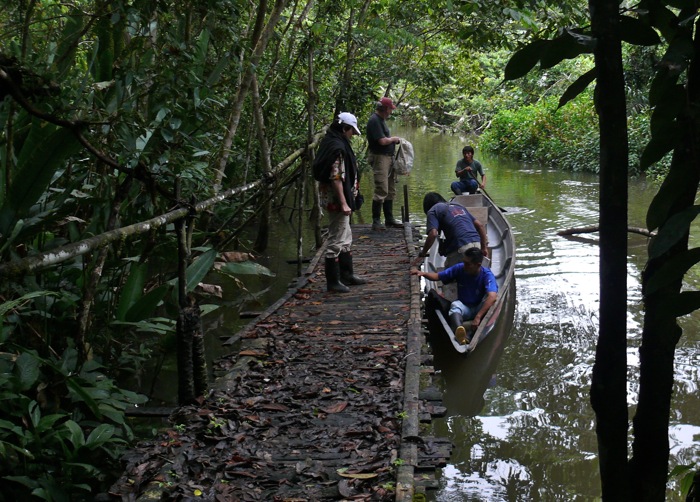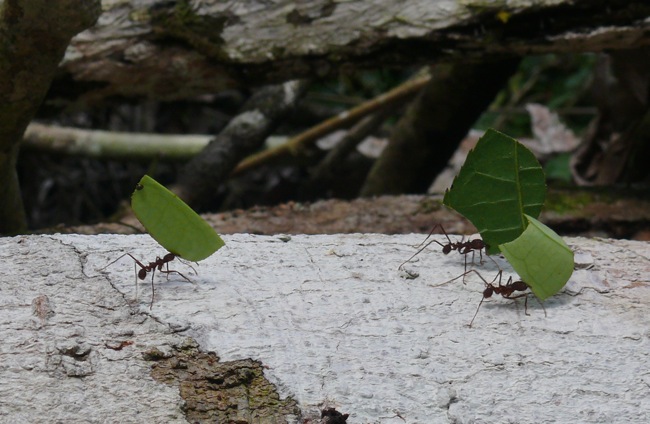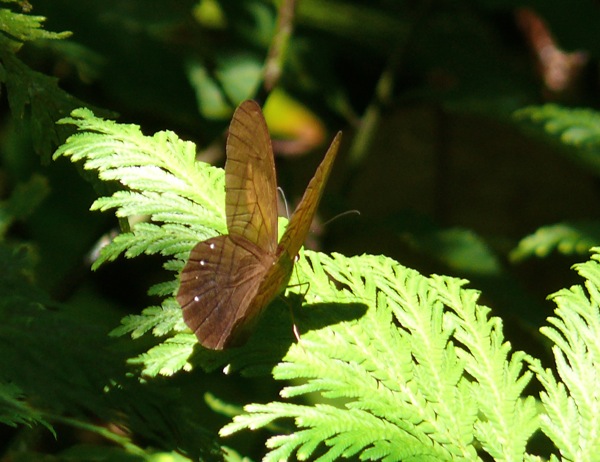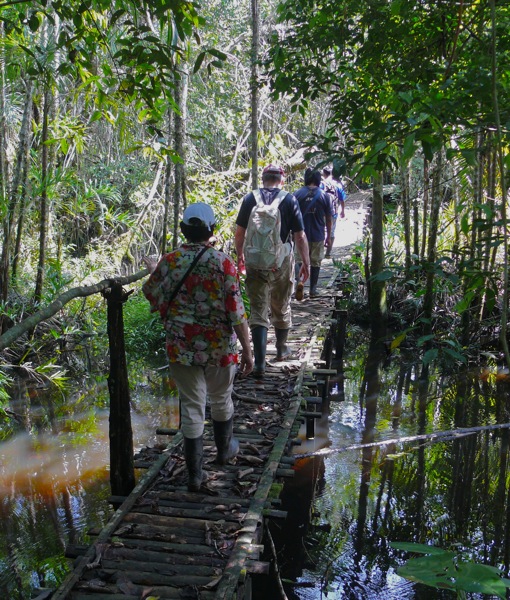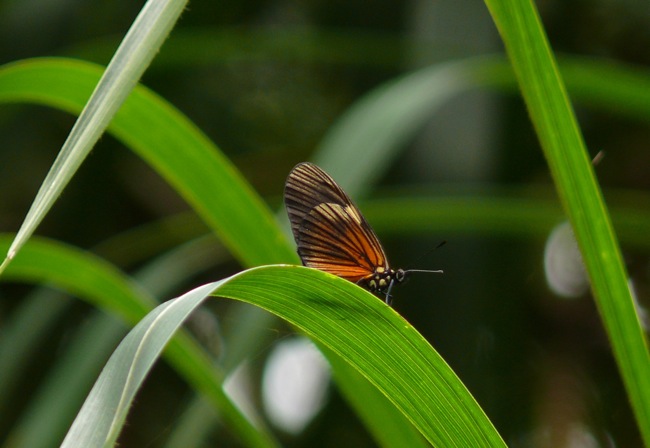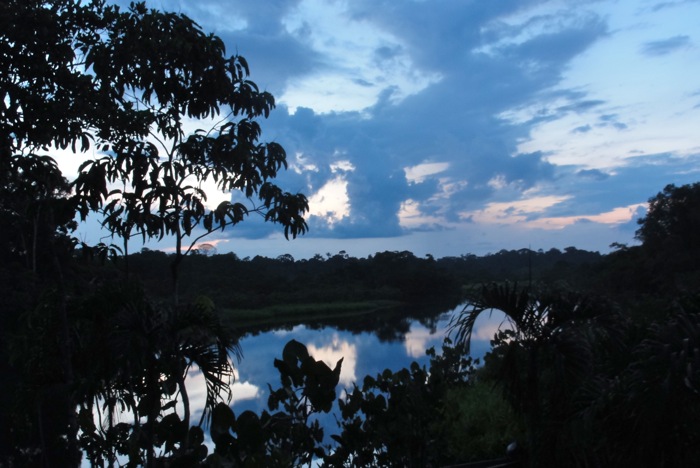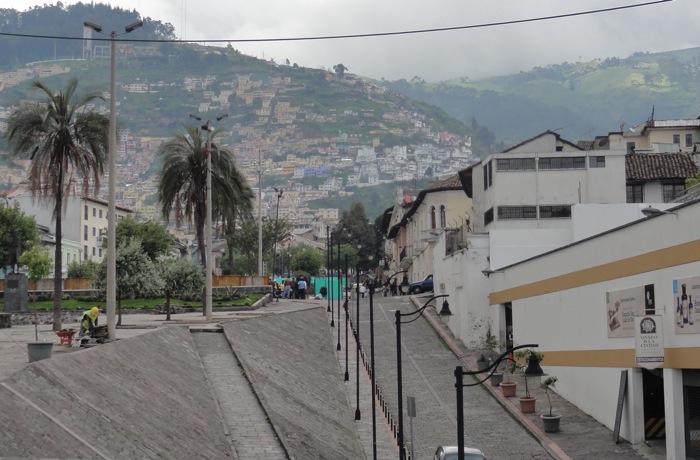The last place we visited in Ecuador was Sani Lodge – a beautiful lodge on a lagoon along the Napo River. To get there we took a plane from Quito, south east over the mountains to a small town called Coca – officially Puerto Francisco de Orellana.
The plane to Coca
The airport in Coca is tiny, with one small terminal space for people and luggage. There was a large moth fluttering around the room – landing on everyone. A few of the kids and I chased around after it, trying to get a picture. Here it was sitting on my backpack. It’s a Letis sp. – sometimes called a Witch moth. It had a wing span of about 8 inches.
We rode taxis through town, and then got into a long, narrow flat-bottomed boat to ride to Sani Lodge. The lodge is a 3 hour boat ride down the Napo River. This is looking back at the dock in Coca from the boat.
Our lunch – served to us on the boat. Passionfruit and a sandwich wrapped in a leaf.
The river was shallow, with lots of sandbars that the driver had to avoid by zig-zagging back and forth across the river. The banks were rainforest jungle, with oil company rigs, and small settlements of wooden houses with thatched roofs.
Karin and Stephan – folks from Germany who became good friends
There were all kinds of boats on the river. This was a dugout canoe. There aren’t many roads, so the river is the “highway”.
There were lots of barge-like boats with colorful cabins carrying all different kinds of freight
Including trucks
3 hours down the river we transferred into a smaller boat to go through a narrow channel to the lagoon. This is a look back at the bigger boat.
Heading down the narrow channel
This is the lagoon, and our first look at the lodge. Endangered Black Caimans (large reptiles similar to alligators) live in the lagoon, so to protect them, motors aren’t allowed in the lagoon. As we got to the lagoon, the boat motor was switched off, and we were paddled across to the lodge.
Resting in the bar after our trip
Sani Lodge is owned and run by a Quechua community – a group of indigenous people who live in the Amazon region of South America.
The bar is a many sided building with wide windows (no glass) that look out on the lagoon.
Here are a few of the wonderful people who we met during our stay there.
Mari – she and her husband, Patricio, are managers of the lodge.
Luis – the bartender
Javier – our guide. He was a wonderful guide – fun to be with, very knowledgeable about the plants and animals we saw, and very good at spotting interesting things to look at.
Our cabin
A cool little lizard that we found on a rug in the cabin
A Hoatzin – an odd turkey-like bird that was quite common in the forest and around the lodge.
That first night Javier took us on a night hike – first a short canoe ride to another part of the lagoon, then a walk along a jungle path in the dark – with flashlights – looking for night creatures. This was a huge frog – bigger that my spread hand – so it must have been at least 9 or 8 inches long.
An iguana on a tree trunk
A very colorful little snake twining around the branches of a small tree. The snake was thin but I think it was several feet long.
Interesting looking looking insect damage around the edge of a leaf. Javier said that many plants make poisons to discourage insects from eating them, but the poisons are concentrated in the middle of the leaves. So the strategy for some insects is to eat around the outer edges of the leaves, to avoid the poisons.
A Tarantula, hiding under a leaf.
A not very good picture of another tarantula. It was big – larger than my hand.
Javier found lots of large insects sitting on leaves for us to look at. Many were katydids or grasshoppers or walking sticks. This is a walking stick – 6 or 7 inches long.
The next day we got up very early and went off to watch the sun rise from a tree house up in the canopy of the forest.
The water in the lagoon was very still, but we could see and hear lots of parrots flying over. Every morning the parrots fly from their night roosts to trees that have edible fruits.
Javier watching for birds
This is the tree that holds the tree house. It’s a huge tree – to get to the top we climbed up the metal tower that’s next to the trunk.
The tower
Sunrise from the top
The branches of the tree were covered with epiphytes – orchids, moss and bromeliads
One of the orchids – probably a Maxillaria sp.
These beetles were on a plant at the base of the tower. They’re called Pleasing Fungus Beetles.
Fern
Javier standing next to a Walking Palm. These are above ground roots, but there is debate about what function they have for the plant. One theory is that by growing new roots on the sunnier side of the tree, they may allow the tree to “walk” to an area that has more sun.
The roots have sharp thorny points on the surface.
Getting back in the boat – this is the canoe we used to travel in the lagoon.
Oropendola nests. Oropendolas are large birds related to Orioles, and they make similar, but much larger nests. They like to nest close together, so some of the tallest trees have lots of these huge woven nests hanging from them. Some nests can be as much as 7 feet long.
A Hoatzin on a nest
Along one of the small “streams” leading away from the main part of the lagoon.
Back at the lodge
The dock and our boat in the early morning
A Capped Heron
This is an Owl Butterfly – (Caligo sp.). It was the largest butterfly I’d ever seen – the wings were 8 or 9 inches long. They fly at dawn and dusk. During the day they rest on tree trunks or branches.
Another species of Owl Butterfly. This one was dead, so we were able to come right up to it, and look at the beautiful blue upper surface of its wings.
This is a Heliconia – often called a Bird of Paradise. This species is insectivorous – water collects in the cups, insects get trapped there, and are dissolved and digested by the plant.
Another forest flower – I suspect it’s hummingbird pollinated because of the red color.
A Clearwing Butterfly
Tiny scarlet mushrooms
A very small toad – it’s called a Crested Forest Toad (thanks to Tim Payne for the ID)
Another large, red, probably hummingbird pollinated flower. This was hanging down from the canopy from a vine, in an open space in the forest.
Leaf cutter ants
Pierella butterfly – this is the only genus of butterflies that has hind wings that are larger then their forewings.
Boardwalk across a wet area
Unidentified butterfly
This is Timothy Paine. He is very interested in frogs and snakes, and takes amazing photos of them. (Check out his wonderful photos on his web site.) He was staying at the lodge, exploring the area, and finding animals to photograph. We spotted this skink on the floor of the dining room, and he took a flying leap across the room and caught it.
Black-spotted Skink (ID thanks to Tim Paine – To read about Tim’s adventures catching and photographing reptiles at Sani Lodge – including these – click on the latest story on his web site.)
A snake that he had found near the lodge. It’s a juvenile Mussurana. (Again, ID thanks to Tim Paine)
We had one sunny afternoon that I spent wandering around the lodge area, looking for butterflies.
A Purplewing – Eunica sp. This was a very friendly butterfly – it fluttered around me and landed on my hands.
Cambridge Blue – Pseudolycaena marsyas – a large showy hairstreak
A Queen Flasher
Sunset over the lagoon
The way back to Coca. In addition to the tourists, the boats take people from the community to other places along the river.
Back at the dock at Coca
The bus we took from the dock to the airport
We had a few hours to walk around Quito that afternoon. Then we had a farewell dinner with Karin and Stephan, and flew back to Minnesota early the next morning.
Mike put together a wonderful video of our Sani Lodge visit – it gives a much better sense of what it was like than just looking at photos.
A park in Quito – there were always people outside, walking around and sitting in parks, in all these cities.
More views of Quito
A shop selling cooking pots
Our hotel – the courtyard
And from the outside





